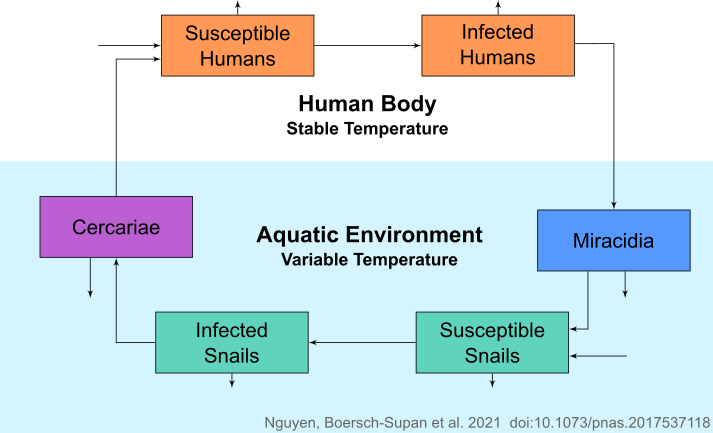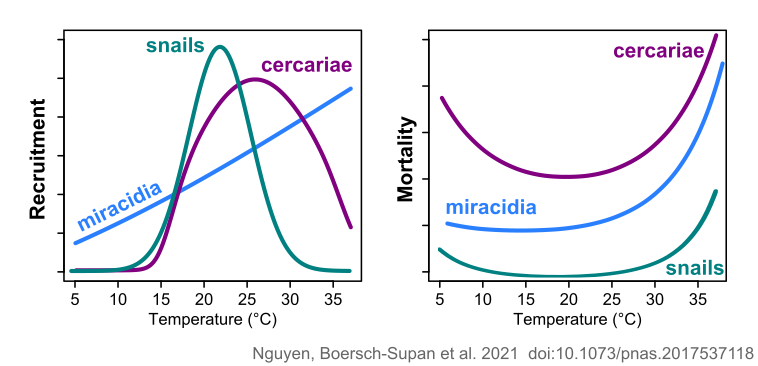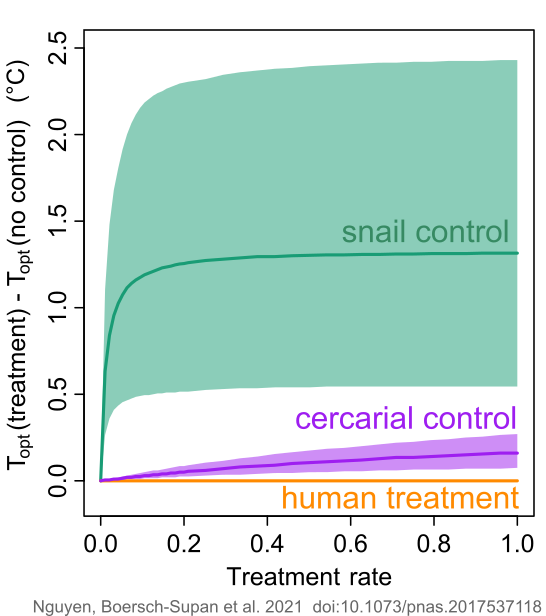New paper - Interventions can shift the thermal optimum of parasitic disease transmission
09 Mar 2021 Philipp Boersch-Supan disease ecology paper Tweet this!Temperature influences the transmission of many diseases, but the effects of temperature variability on the transmission of parasitic diseases are poorly understood. A new paper co-led by Karena Nguyen (Emory University) and myself and published in PNAS(https://doi.org/10.1073/pnas.2017537118) investigates the influence of water temperature on the transmission risk for schistosomiasis, a disease that affects over 200 million people annually. Schistosomiasis is caused by parasitic worms which develop in fresh water snails and infect humans and livestock when they come into contact with contaminated water.

We found that temperature affects each life stage of the parasite and the intermediate snail differently, and that these differences shape disease transmission and the effects of interventions.

Combining the information on temperature-specific traits in an epidemiological model, showed that transmission risk peaks when water warms to 21.7 degrees centigrade.
The model also allowed us to simulate interventions targeting the disease in different ways, for example by treating humans or removing snails. The simulation results showed that removing snails was the most effective intervention to reduce transmission, especially when applied at low environmental temperatures. Surprisingly, simulated snail removal also raised the optimal temperature for transmission by up to 1.3 degrees centigrade.

This is because interventions like chemical treatments amplify snail mortality at all temperatures, and while this decreases disease transmission overall, it also allows the peak of transmission risk to occur at higher temperatures, which benefit the hatching of parasite eggs.
Our findings can guide public health workers to take regional water temperatures and their seasonal fluctuations into account when planning interventions that target aquatic parasites and their intermediate hosts.
The paper originated in a “quick statistical question” Karena had about the experimental work for her PhD thesis at the University of South Florida, while I was a postdoc there and at the University of Florida. The project then developed into a fun collaboration that combined experiments, data synthesis and mathematical and statistical models. Additional authors of paper are Jason Rohr (Notre Dame University), Valerie Harwood (University of South Florida), David Civitello, Rachel Hartman and Sandra Mediola (Emory).
The work was funded by the National Institutes of Health, the National Science Foundation, the Porter Foundation and the U.S. Department of Agriculture.
KH Nguyen*, PH Boersch-Supan*, RB Hartman, SY Mendiola, VJ Harwood, DJ Civitello, JR Rohr (2021)
Interventions can shift the thermal optimum for parasitic disease transmission.
Proceedings of the National Academy of Sciences
doi:10.1073/pnas.2017537118
*joint corresponding authors